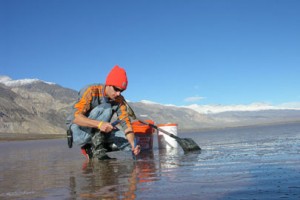Examining microorganisms that have survived in geologic materials for tens of thousands to millions of years has been the focus of research conducted by Brian Schubert ’04, assistant researcher, Department of Geology and Geophysics, University of Hawaii.

Brian Schubert '04 collecting brine and salt samples (halite) in Saline Valley, California.
The April issue of EARTH magazine features an article about the research, written by Tim Lowenstein, professor of geology, State University of New York at Binghamton, who was Schubert’s dissertation adviser. Schubert and Michael Timofeeff, a postdoctoral researcher, were major collaborators with Lowenstein. They have shown that bacteria-like archaeans have lived inside tiny enclosures in salt crystals for up to 22,000 to 34,000 years.
Schubert explains that the importance of these tiny microbes, called Archaea, is that they could provide information about ancient life on Earth as well as suggesting the possibility of finding life beneath the surface on other planets.
Archaea were only discovered in the early 1970s. Like bacteria, they are single-celled prokaryotes, but DNA analysis showed that their metabolic systems are different. As a result, scientists devised a new system for classifying life—the three Domains are Eukaryota, Eubacteria, and Archaea.
Archaea exist in unusual conditions that are harmful and uninhabitable to most other organisms on Earth–such as extremely hot, acidic, or alkaline (salty) environments.
Schubert studies Archaea that are extreme halophiles; they can only live in extremely salty environments. The minimum salt concentration they require is 9%, while many can survive in solutions that are up to 32% salt. One well-known natural habitat for halophiles is the Great Salt Lake in Utah.
For most of his work, Schubert collected brine and salt samples (halite) in Saline Valley, California. He explains that microbes living in the salt brines get trapped within fluid inclusions in the salt when it crystallizes.
Schubert says every crystal that contains live archaeans also contains dead cells from a salt-lake alga known as Dunaliella that has high concentrations of glycerol. “The microbes use glycerol as a carbon source,” he says. “It is essentially their food. The metabolic rates for these microbes, once they are trapped, is very low so they require very little energy (i.e. carbon) to survive. Based on these low metabolic rates, we calculated that one algal cell contains enough glycerol for one archaean to survive for up to 12 million years in the salt!”
At Lafayette, Schubert completed an honors thesis based on his research of sediment in the Bushkill Creek and of the local watershed, which was advised by Dru Germanoski, Van Artsdalen Professor of Geology and department head.
Schubert’s current research is focused on using stable isotopes on biological substrates (modern and ancient) to learn about the geologic past. For instance, he is growing plants in chambers with concentrations of CO2 estimated for the last 100 million years to quantify isotopic and biomass changes that result.
Their study was published in January in The Geological Society of America’s open-access journal GSA Today.
